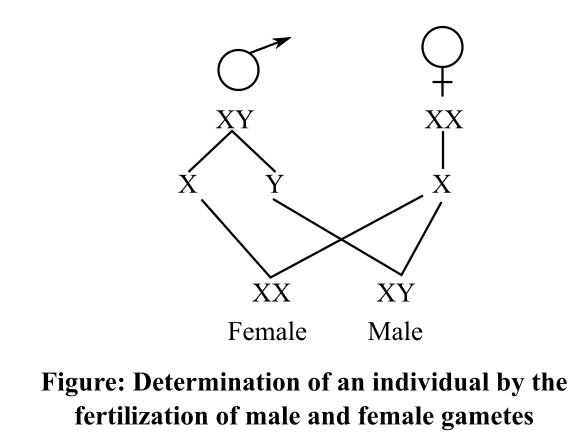
Concept explainers
Define the terms diploid and haploid, and explain how the chromosomal sex of an individual is determined.
To review:
The terms diploid and haploid along with the process of determining the chromosomal sex of an individual.
Introduction:
Most of the cells in the human body have 23 pair of chromosomes, that is, 46 chromosomes. Chromosomes are the compact structures formed by the double helix DNA (deoxyribonucleic acid) molecules wrapped around the histone proteins. DNA contains the genetic information inherited by the parents.
Explanation of Solution
Diploid is a condition of a cell where the cell has two sets of chromosomes obtained from parents. The total number of chromosomes in a cell is 46 out of which 23 are obtained from the mother and the remaining 23 are obtained from the father.
Haploid is the condition when the cells have half the number of chromosomes (that is 23). The gametes are the only cells that are present in a haploid state that in turn become diploid after the fertilization of both male and female gametes and result in a diploid zygote.
The female sex chromosome is represented as XX and the male sex is represented as XY. The diagram below depicts the combination of these chromosomes during fertilization and resulting in the formation of the male and female zygote:

The XX combination results in a female child whereas the combination of female X with the male Y chromosome results in a combination of XY, which leads to a male child.
Want to see more full solutions like this?
Chapter 20 Solutions
Human Physiology
- Identify the major events that occur in each phase of meiosis AND draw a labelled diagram.arrow_forwardList and describe two specific differences between meiosis I and meiosis II.arrow_forwardDifferentiate between life cycle showing zygotic meiosis and life cycle showing gametic meiosis.arrow_forward
- Draw the distribution of DNA (one set of homologous chromosomes) during meiosis. What happens in Meiosis I (prophase I, Metaphase I, Anaphase I and Telophase I and interkinesis) and in Meiosis II (prophase II, Metaphase II, Anaphase II and Telophase II and interkinesis).arrow_forwardWhat processes contribute to genetic diversity in meiosis? Describe in detail the event that occurs in prophase I.arrow_forwardCompare and contrast phases of meiosis I with phases of meiosis II in terms of the events taking place and the behaviour of chromosomes.arrow_forward
- Describe each stage of Meiosis: MEIOSIS I PROPHASE 1- METAPHASE 1- ANAPHASE 1- TELOPHASE 1- MEIOSIS II PROPHASE II- METAPHASE II- ANAPHASE II- TELOPHASE II-arrow_forwardDescribe how meiotic and mitotic nondisjunction occur and identify their possible phenotypic consequences?arrow_forwardIndicate the stage of meiosis (e.g., metaphase 2 = M2; prophase 1 = P1; anaphase 2 = A2; etc.) in which each of the following events occurs. first cell stage in which the original maternal/paternal chromatid doublets (chromosomes) are in separate cells chromosomes (chromatid doublets) first synapse (tetrads are visible) chromosomes (chromatid doublets, but NOT tetrads) line up in single file one doublet next to the other crossing over and recombination occurschromatid doublets move toward opposite poles of cellchromosomes (DNA) replicatechromatids separate as centromeres dividechromosomes (chromatid doublets) line up as tetrads at the cell’s equatorarrow_forward
- Describe meiosis and its overall goal for reproduction. Use terms: homologous chromosomes, meiosis l, meiosis ll, 46 (diploid), 23 chromosomes (haploid), genetic recombination, random alignment, crossing over in meiosis l to create diverse and unique gametes.arrow_forwardBriefly describe TWO events during meiosis that contribute to genetic variation in the gametes.arrow_forwardWhich statement is true of meiosis? 1)two identical cells in both divisions 2)the first division produces haploid cells and the second produces diploid cells 3)the first division produces diploid cells and the second produces haploid cells 4) the products of both meiotic divisions are haploidarrow_forward
 Human Physiology: From Cells to Systems (MindTap ...BiologyISBN:9781285866932Author:Lauralee SherwoodPublisher:Cengage Learning
Human Physiology: From Cells to Systems (MindTap ...BiologyISBN:9781285866932Author:Lauralee SherwoodPublisher:Cengage Learning
